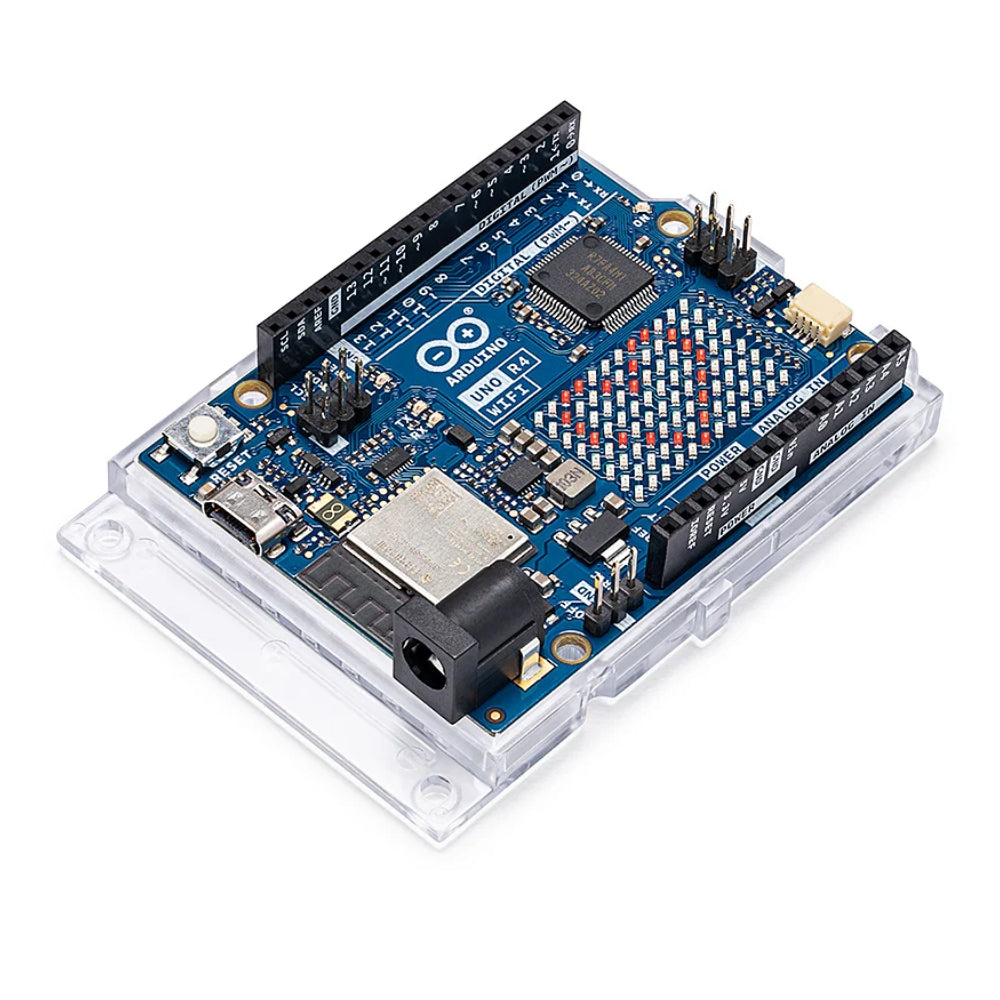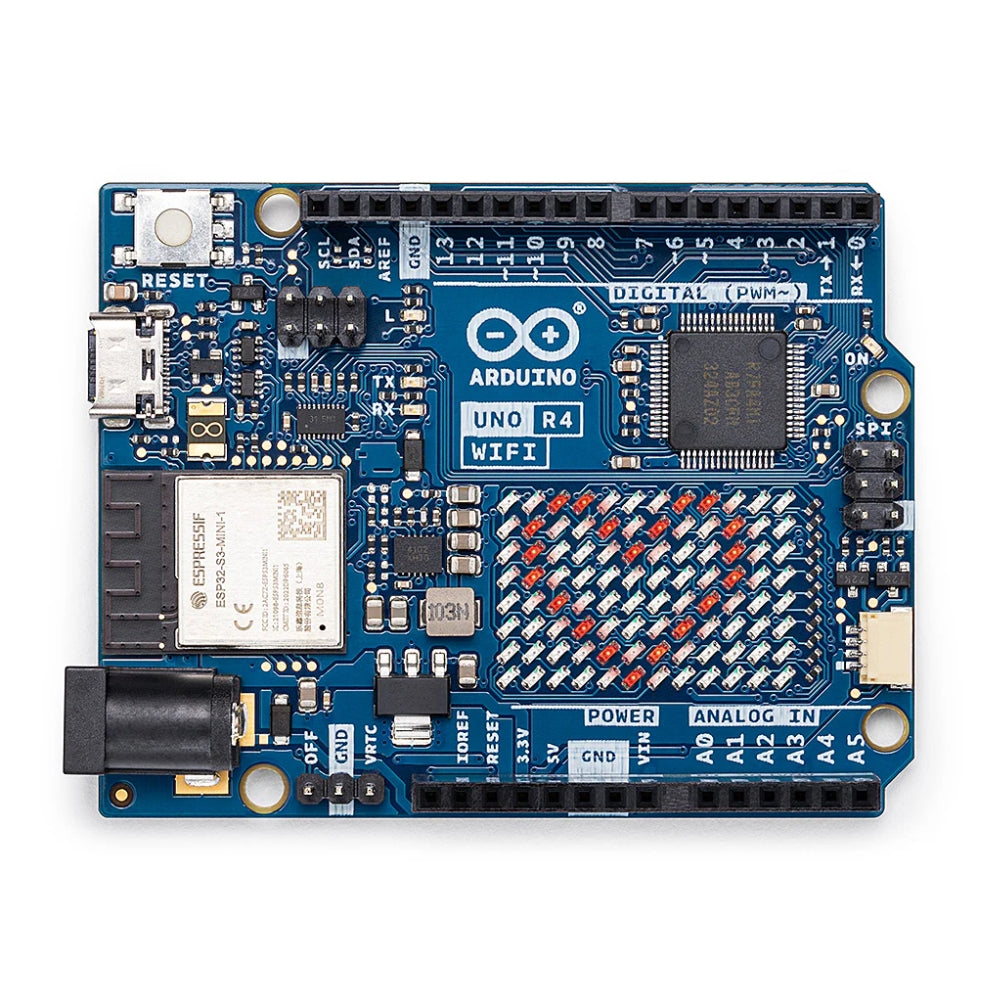Description
Arduino UNO R4 WiFi
The Arduino Uno R4 Wi-Fi is a microcontroller board based on the Renesas RA4M1 (32-bit ARM Cortex-M4) processor and equipped with integrated Wi-Fi functionality, enabling easy development of IoT (Internet of Things) applications. It is a part of the popular Arduino Uno family, providing an upgraded experience with more computational power, additional memory, and wireless connectivity options. The board is backward compatible with Arduino Uno shields and accessories, making it a versatile platform for a wide range of projects.
This version of the Arduino Uno is specifically designed to support Wi-Fi communication, facilitating the creation of connected devices for remote control, automation, monitoring, and more. It supports various development tools and libraries, including the Arduino IDE, making it accessible to hobbyists and professionals alike.
Technical Specification:
- Microcontroller: Renesas RA4M1 (ARM Cortex-M4)
- Operating Voltage: 5V
- Input Voltage (recommended): 7-12V
- Input Voltage (limits): 6-20V
- Digital I/O Pins: 14 (of which 6 can be PWM outputs)
- Analog Input Pins: 6
- PWM Pins: 6
- Flash Memory: 512 KB
- SRAM: 128 KB
- EEPROM: 32 KB
- Clock Speed: 48 MHz
- Wi-Fi Module: Integrated ESP32-WROOM-32 (supports 2.4 GHz Wi-Fi)
- USB to Serial: Native USB connection (for programming)
- Power Supply: 5V via USB or external power jack (with onboard voltage regulator)
- Dimensions: 68.6mm x 53.4mm
Features:
- Wi-Fi Connectivity: Built-in Wi-Fi (via ESP32-WROOM-32) for easy Internet and network connection.
- 32-bit Processor: Powered by a high-performance Renesas RA4M1 32-bit ARM Cortex-M4 processor.
- Large Memory: 512 KB Flash memory, 128 KB SRAM, and 32 KB EEPROM for handling more complex applications.
- Compatibility with Arduino Ecosystem: Fully compatible with existing Arduino shields, sensors, and accessories.
- USB Interface: Easy programming via native USB interface, no additional programmer required.
- Improved Performance: Faster processing speed and higher RAM capacity compared to the original Arduino Uno.
- GPIO Pins: 14 digital I/O pins (6 PWM outputs, 6 analog inputs).
- Security Features: Secure Wi-Fi connection support for IoT applications.
- IDE Support: Compatible with the Arduino IDE for development, programming, and debugging.
- Low Power Consumption: Designed for efficient power usage, making it suitable for battery-powered projects.
Pin Description:
-
Power Supply Pins:
- Vin: Input voltage to the board (7V to 12V recommended).
- 5V: 5V output from the onboard regulator.
- 3.3V: 3.3V output for powering low-power components.
- GND: Ground pins (2x).
-
Digital I/O Pins (D0 - D13):
- Can be used as input or output.
- Some of these pins also support PWM, I2C, SPI, and UART communication.
-
Analog Inputs (A0 - A5):
- Used for reading analog sensors, such as temperature or light sensors.
-
SPI Pins:
- MOSI (D11), MISO (D12), SCK (D13), and SS for SPI communication.
-
I2C Pins:
- SDA (A4) and SCL (A5) for I2C communication.
-
Serial Communication Pins:
- RX (D0) and TX (D1) for UART serial communication.
Applications
- IoT Projects: Perfect for creating Internet of Things devices like smart home automation systems, weather stations, and remote-controlled devices.
- Smart Sensors: Used for connecting various sensors (temperature, humidity, motion) and sending data over the internet.
- Robotics: Can be integrated into robots for Wi-Fi control, telemetry, and remote monitoring.
- Home Automation: Control lights, fans, locks, or other appliances through Wi-Fi-enabled devices.
- Wearable Devices: Implement in wearable health-monitoring systems that need to communicate wirelessly.
- Remote Monitoring Systems: For real-time monitoring of environments or systems such as agriculture, industrial equipment, and vehicles.
- Smart Appliances: Develop smart kitchen appliances, smart locks, and security systems with Wi-Fi functionality.
- Educational Purposes: Ideal for students and beginners to learn about microcontrollers, sensors, and wireless communication.




